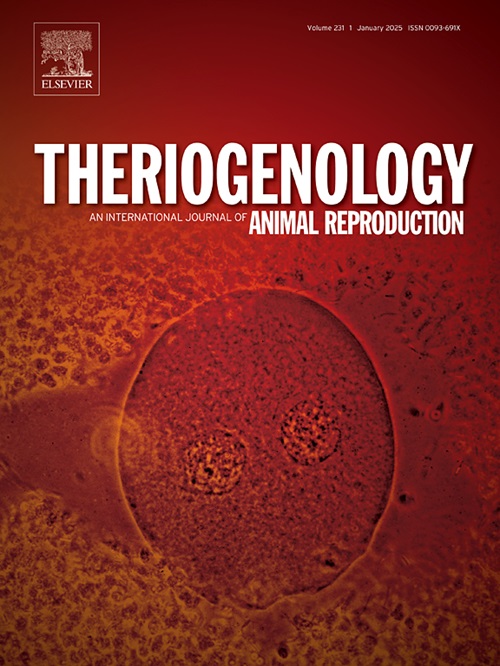在体外培养条件下,集落刺激因子2 (CSF2)对细胞和分子参数或囊胚率没有显著影响
IF 2.4
2区 农林科学
Q3 REPRODUCTIVE BIOLOGY
引用次数: 0
摘要
集落刺激因子2 (CSF2)是培养后第5 ~ 7天用于促进胚胎发育的胚胎因子。我们从第4天开始评估其在降低营养浓度培养基中的使用情况。假定受精卵被分配到三个处理:对照-合成输卵管液(SOF), CSF2 D1 (SOF + CSF2,第1-7天),CSF2 D4 (SOF + CSF2,第4-7天)。观察第4天的卵裂率和第6、7天的囊胚率。第7天,利用扩增后的囊胚评估线粒体活性、脂质定量、细胞总数、基因表达和DNA甲基化模式。胚胎发育资料采用卡方检验(P≤0.05)。正态分布的数据采用方差分析和Tukey检验,非正态分布的数据采用Kruskal-Wallis检验和Mann-Whitney检验。第7天的卵裂率和囊胚率相似(P >;0.05)。在11个被评估的基因中,只有胎盘特异性8基因在CSF2培养第4天的胚胎中转录量较低(P≤0.05)。DNA甲基化、脂滴染色、线粒体活性和总细胞数的评估在处理间无显著差异(P >;0.05)。综上所述,与第4天添加CSF2相比,在培养基中添加降低营养浓度的CSF2对评估参数没有影响,并且可以在整个培养期间使用,而不会影响胚胎的产生和发育动力学。本文章由计算机程序翻译,如有差异,请以英文原文为准。

Colony-stimulating factor 2 (CSF2) does not significantly affect cellular and molecular parameters, or blastocyst rates under in vitro culture conditions with reduced nutrient concentrations
Colony-stimulating factor 2 (CSF2) is an embryokine used between days 5 and 7 of culture to improve embryonic development. We evaluated its use from Day 4 and throughout the culture period in a reduced nutrient concentrations culture medium. Presumptive zygotes were assigned to three treatments: Control – synthetic oviduct fluid (SOF), CSF2 D1 (SOF + CSF2 from Day 1–7), CSF2 D4 (SOF + CSF2 from Day 4–7). Cleavage rates on Day 4 and blastocyst rates on days 6 and 7 were evaluated. On Day 7, expanded blastocysts were used to assess mitochondrial activity, lipid quantification, total cell number, gene expression and DNA methylation patterns. Embryo development data were analyzed using the chi-square test (P ≤ 0.05). Data normally distributed were analyzed with ANOVA and Tukey's test, while non-normally distributed data were evaluated using the Kruskal-Wallis and Mann-Whitney tests. Cleavage and blastocyst rates on Day 7 were similar (P > 0.05) among treatments. Of 11 genes evaluated, only Placenta-specific 8 presented a lower number of transcripts (P ≤ 0.05) in embryos cultured with CSF2 from Day 4. Assessments of DNA methylation, lipid droplet staining, mitochondrial activity and total cell number showed no significant differences among treatments (P > 0.05). In conclusion, CSF2 had no effect on the assessed parameters when a culture medium with reduced nutrient concentrations was used, and can be used throughout the entire culture period without affecting embryo production and developmental kinetics compared to CSF2 added on Day 4.
求助全文
通过发布文献求助,成功后即可免费获取论文全文。
去求助
来源期刊

Theriogenology
农林科学-生殖生物学
CiteScore
5.50
自引率
14.30%
发文量
387
审稿时长
72 days
期刊介绍:
Theriogenology provides an international forum for researchers, clinicians, and industry professionals in animal reproductive biology. This acclaimed journal publishes articles on a wide range of topics in reproductive and developmental biology, of domestic mammal, avian, and aquatic species as well as wild species which are the object of veterinary care in research or conservation programs.
 求助内容:
求助内容: 应助结果提醒方式:
应助结果提醒方式:


